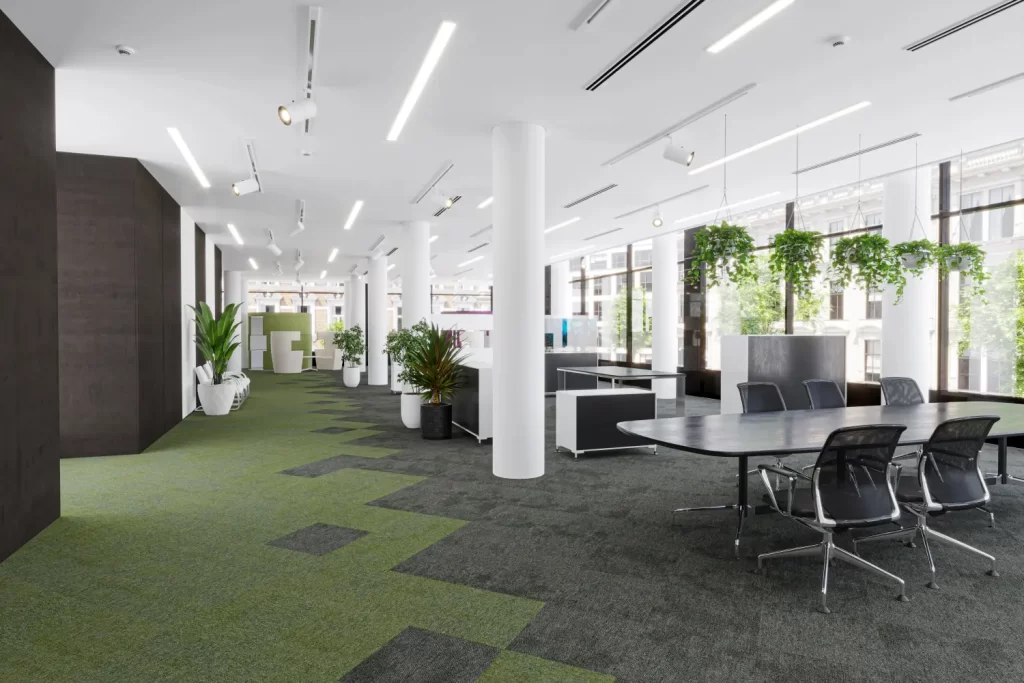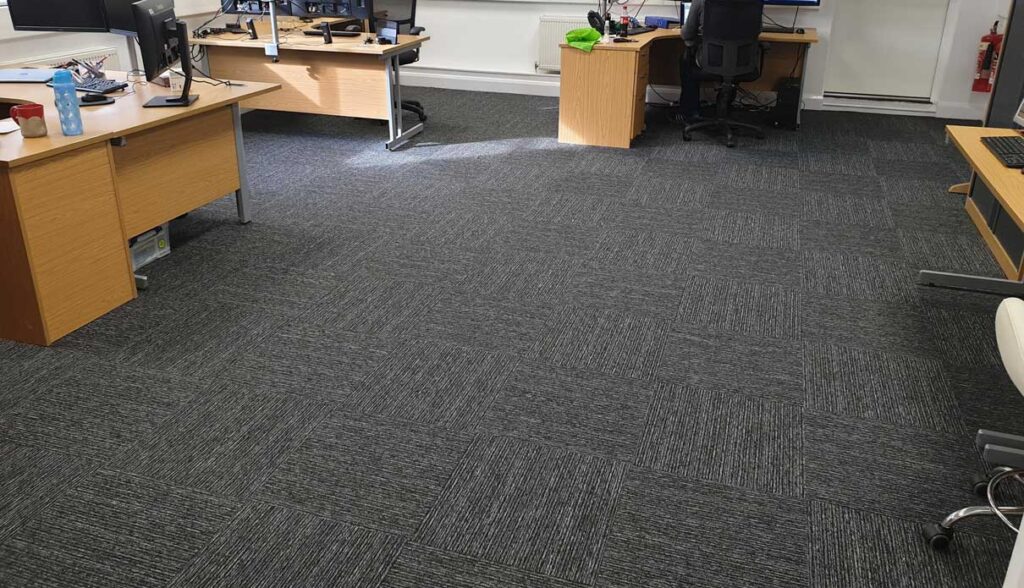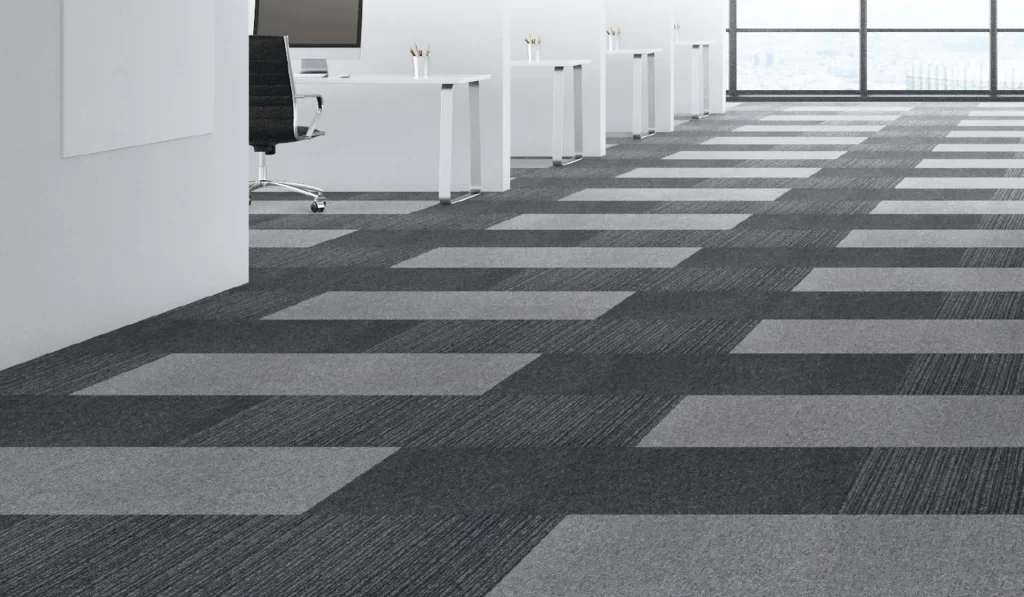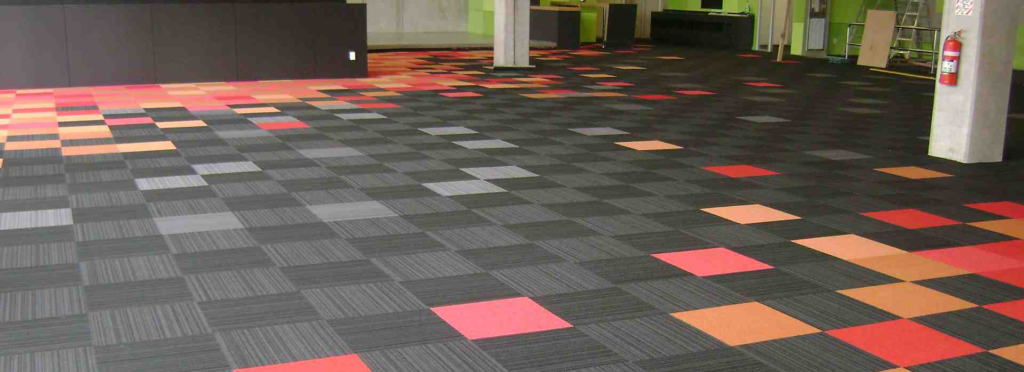
When it comes to flooring options for commercial spaces, carpet tiles have quickly become a favourite choice for businesses of all sizes. Offering the perfect blend of practicality, style, and value, commercial carpet tiles provide a flexible solution that suits a wide range of environments, from busy office floors to bustling retail stores. Their modular design, easy installation, and durability make them an ideal investment for companies looking to create a professional and welcoming atmosphere without the fuss and expense of traditional broadloom carpets.
In this guide, we will explore everything you need to know about commercial carpet tiles — from understanding the different types available to choosing the right style for your space. We will also look at key advantages, installation tips, maintenance advice, and common mistakes to avoid, ensuring you are well-equipped to make an informed decision. Whether you are renovating an existing property or fitting out a brand-new commercial space, this comprehensive guide will help you achieve the perfect flooring solution with ease.
What Are Commercial Carpet Tiles?
Commercial carpet tiles, often referred to as modular carpet, are individual squares of carpeting that can be fitted together to cover a floor. Unlike traditional broadloom carpets that come in large rolls, carpet tiles are designed to be laid down piece by piece, offering greater flexibility in terms of installation, design, and maintenance.
One of the main differences between residential and commercial carpet tiles is the level of durability. Commercial tiles are manufactured specifically to withstand high foot traffic and are typically made from tougher, more resilient materials such as nylon or polypropylene. These fibres are known for their ability to resist crushing, staining, and general wear and tear, making them a practical choice for busy environments like offices, hotels, retail spaces, and educational institutions.
Commercial carpet tiles also often feature a low pile height and dense construction, which contributes to their long lifespan and easy maintenance. Available in a vast range of colours, patterns, and textures, they offer businesses an excellent opportunity to enhance the look and feel of their interiors while ensuring functionality remains a top priority.
Advantages of Using Carpet Tiles in Commercial Spaces
There are many reasons why carpet tiles have become the flooring of choice for commercial spaces. One of the biggest advantages is their ease of installation. Unlike broadloom carpet, which often requires professional fitting, carpet tiles can be installed with minimal disruption. Individual tiles can be quickly placed, removed, or replaced, making it simple to address damage or update a design without having to replace an entire floor.
Design flexibility is another major benefit. With commercial carpet tiles, businesses can mix and match colours, patterns, and textures to create custom layouts that reflect their branding or add visual interest to a space. Whether you want a uniform, professional look or a bold, creative design, carpet tiles give you endless possibilities.
Durability is also a key feature. Commercial carpet tiles are built to endure heavy use and are resistant to stains, fading, and wear. This makes them ideal for high-traffic areas where longevity is essential. Additionally, their modular nature allows for economical repairs — you can simply replace a damaged tile rather than re-carpeting an entire room.
Beyond practicality, carpet tiles also offer acoustic benefits. In busy commercial settings, controlling noise levels is important, and carpet tiles help to absorb sound, creating a quieter and more comfortable environment for staff and customers alike.

Types of Commercial Carpet Tiles
Choosing the right type of carpet tile is essential to ensure your flooring performs well in a commercial environment. There are several types to consider, each offering different benefits depending on the needs of your space.
Loop Pile Carpet Tiles
Loop pile carpet tiles are made by looping yarn through the backing material, creating a durable and resilient surface. This type is especially suited for high-traffic areas as it resists crushing and maintains its appearance over time. Loop pile tiles often have a more textured look, which can help disguise dirt and wear, making them ideal for busy offices and corridors.
Cut Pile Carpet Tiles
In cut pile carpet tiles, the loops are cut to create an upright pile. This results in a softer, more plush feel underfoot, which can add a touch of luxury to spaces like executive offices or hotel suites. While they are less durable than loop pile options, modern manufacturing techniques have made cut pile tiles more robust and suitable for many commercial settings.
Needle-Punch Carpet Tiles
Needle-punch carpet tiles are created using a manufacturing process that entangles fibres together without using traditional weaving or tufting. These tiles are highly durable, easy to maintain, and typically more economical, making them a good choice for industrial areas or temporary installations where budget is a concern.
Modular vs. Broadloom Patterns
Carpet tiles are naturally modular, which provides more design flexibility compared to traditional broadloom carpet. Businesses can create unique layouts using different colours or patterns, or opt for a uniform look that mimics broadloom. The ability to install in different patterns, such as quarter-turn or ashlar, allows further customisation to suit the style and practical needs of a space.

Key Factors to Consider When Choosing Carpet Tiles
Selecting the right carpet tiles for your commercial space involves more than just picking a colour you like. Several important factors should guide your decision to ensure the flooring performs well and supports your business environment.
Traffic Levels
The amount of foot traffic your space receives is a crucial consideration. High-traffic areas, such as hallways, reception areas, and open-plan offices, require tiles made from highly durable materials like solution-dyed nylon. For lower-traffic areas, you might opt for softer, more decorative tiles.
Maintenance Requirements
Think about the level of maintenance the carpet tiles will need. Tiles with stain-resistant treatments or darker colours can make ongoing cleaning easier and help the floor look better for longer. Some commercial carpet tiles are designed specifically to hide dirt and stains, reducing the need for constant deep cleaning.
Aesthetic Goals
The look and feel of your flooring can significantly impact the overall atmosphere of your business. Carpet tiles offer an opportunity to reinforce branding through colour choices or to create specific moods — such as calmness in a healthcare environment or energy in a creative workspace. Consider how the design, texture, and pattern will support your company’s image and objectives.
Budget
Cost is always a key factor. While carpet tiles are often more affordable over the long term due to their ease of repair and longevity, there are still varying price points depending on quality, material, and design. Setting a clear budget from the outset can help you balance aesthetics and performance without overspending.
Eco-Friendliness and Sustainability Certifications
More businesses are looking for flooring options that support their sustainability goals. Many manufacturers now offer carpet tiles made from recycled materials or those that contribute towards certifications like LEED (Leadership in Energy and Environmental Design) or have Green Label Plus certification for low emissions. Choosing eco-friendly carpet tiles not only benefits the environment but can also enhance your company’s reputation for corporate responsibility.
Installation Process Explained
Installing commercial carpet tiles is often more straightforward than fitting traditional broadloom carpet, but proper preparation is still essential to achieve a professional finish and long-lasting results.
Preparing the Subfloor
Before installation begins, the subfloor must be properly prepared. It should be clean, dry, smooth, and free of any dust, debris, or irregularities. Any cracks or uneven areas should be repaired to avoid problems with tile adhesion and appearance.
Layout Planning
Careful planning of the layout is crucial. Depending on the design you want to achieve, tiles can be installed in various patterns such as monolithic (all tiles laid in the same direction), quarter-turn (each tile rotated 90 degrees), brick (offset rows like brickwork), or ashlar (brick-like but vertical offset). Dry-laying a few tiles first can help visualise the final look and ensure alignment is correct.
Adhesives and Underlay Options
Some carpet tiles come with a peel-and-stick backing, while others require pressure-sensitive adhesive or tackifier to secure them in place. In some cases, using a cushioned underlay beneath the tiles can improve comfort underfoot and enhance acoustic properties. It is important to follow the manufacturer’s guidelines for adhesive and underlay use to ensure performance and warranty compliance.
Professional vs. DIY Installation
While many businesses choose professional installation for speed and precision, particularly in larger areas, smaller spaces may be suited to a DIY approach. The modular nature of carpet tiles means that minor mistakes can be corrected easily, and damaged tiles can be swapped out without much fuss.
Maintenance and Care Tips
One of the major benefits of commercial carpet tiles is how easy they are to maintain compared to other flooring options. With a few simple care practices, you can keep your tiles looking fresh and extend their lifespan considerably.
Regular Vacuuming and Spot Cleaning
Regular vacuuming is essential to remove dirt, dust, and debris that can cause wear over time. High-traffic areas may require daily vacuuming, while lower-use zones may only need attention a few times a week. For spills and stains, prompt spot cleaning is key. Most commercial carpet tiles are designed to resist staining, but quick action can prevent permanent marks.
Deep Cleaning Schedule
In addition to routine vacuuming, it’s important to schedule periodic deep cleans. Depending on the environment, professional hot water extraction or low-moisture cleaning should be carried out every six to twelve months. Always check manufacturer recommendations to ensure you are using the correct methods.
Replacing Individual Tiles
One of the greatest advantages of carpet tiles is the ability to replace individual tiles if they become damaged or heavily stained. Keeping a small stock of spare tiles from the original installation allows you to swap out sections easily, maintaining a consistent appearance across the floor.
Protecting Against Stains and Wear
Using entrance mats at doorways can help capture dirt and moisture before it reaches your carpet tiles. Rearranging tiles periodically — for instance, moving tiles from lower-traffic areas into higher-traffic zones — can also help even out wear patterns and prolong the overall life of your flooring.

Common Mistakes to Avoid
While commercial carpet tiles are relatively easy to work with, certain mistakes during selection, installation, and maintenance can impact their performance and appearance. Being aware of these pitfalls can help you get the most from your investment.
Ignoring Subfloor Preparation
Skipping proper subfloor preparation is a common error that can lead to an uneven surface, poor adhesion, and visible imperfections. Always ensure the subfloor is clean, dry, and level before laying any tiles.
Poor Planning of Tile Layout
Failing to plan the layout properly can result in awkward cuts at edges, mismatched patterns, or an unbalanced appearance. Taking the time to measure the space accurately and dry-lay a section of tiles first can prevent costly mistakes.
Using the Wrong Adhesive
Not all carpet tiles are installed the same way. Using the wrong type of adhesive, or applying too much or too little, can cause tiles to shift, lift, or develop bubbles over time. Always follow the manufacturer’s recommendations regarding adhesives and installation techniques.
Neglecting Maintenance
Even the most durable carpet tiles require regular maintenance. Skipping routine vacuuming or delaying spot cleaning can cause dirt to grind into the fibres, leading to premature wear and staining.
Not Keeping Spare Tiles
It’s wise to order extra tiles during the initial purchase. Having matching spare tiles on hand makes it easy to replace any that become damaged or stained, helping you maintain a consistent look without needing a full refurbishment.
Conclusion
Commercial carpet tiles offer a smart, versatile flooring solution that combines durability, style, and practicality. From the ease of installation and flexible design options to the straightforward maintenance and cost savings over time, it is easy to see why they have become a popular choice for businesses across all sectors.
By understanding the different types of carpet tiles available, considering key factors like traffic levels and maintenance needs, and avoiding common mistakes, you can select the perfect tiles for your commercial space. Whether you are fitting out an office, a retail store, or a hospitality venue, carpet tiles provide a professional, attractive finish that supports both the aesthetics and functionality of your environment.
With proper installation and care, your commercial carpet tiles will not only enhance the look of your business but also deliver reliable performance for years to come.
Recent Comments